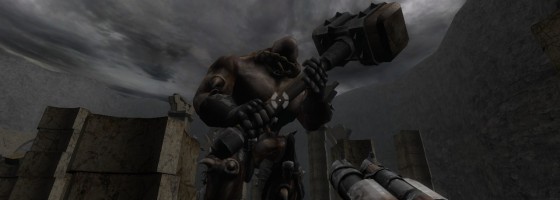When Serious Sam was released, it was a major shock to FPS gamers who were used to corridors and fighting small numbers of enemies. Players found themselves fighting dozens if not hundreds of enemies at one time. While Painkiller did copy Serious Sam’s style, it was an amazing game nonetheless.
Painkiller:
Painkiller’s story was one of those convoluted plots that tried to set up the fact that you were running around killing hundreds of enemies per level. Pretty much all you need to know was that things want to kill you, you have weapons and scene.
While Painkiller’s story wasn’t going to move anyone it was the gameplay that was impressive. From the outside you could look at Painkiller as Serious Sam’s Goth brother but where they differ was the gameplay.
As in Serious Sam, your mission was to get through each level and reach the exit by killing every enemy you see. Enemies differed in terms of attack pattern and health. But where Serious Sam gave the player weapons with basic functions, Painkiller’s developers got creative.
There were no conventional weapons in Painkiller: such as the long range stake firing gun. Every gun both looked and acted differently from each other giving the gunplay variety. Unlike Serious Sam, every weapon had an alternate fire but unlike most shooters where the alternate fire was related to the primary, Painkiller went in a different direction.
The stake gun for instance shot mid-range grenades while the shotgun fires ice blasts that freeze enemies. Painkiller also had one of the best basic weapons in any FPS with the titled Painkiller: a short range chainsaw-like weapon that could also shoot out as the alternate fire.
Painkiller also featured an interesting system in the form of tarot cards that could be applied before a level for the cost of in game currency. These cards provide either passive bonuses or one time activated abilities to help turn the tide of a fight. Every level had a side goal that when accomplished would unlock a new card for the player to experiment with.
While you could beat the game without the use of the cards, this system provided a good reason to replay levels and adjust tactics.
Enemy design overall was somewhat lacking and one area where Serious Sam beat Painkiller. The different enemy models differed enough from each other, but never challenged the player to the same degree as the enemies from Serious Sam.
But while Serious Sam had better enemy designs, Painkiller won in the boss department. Every chapter of the game ended with a fight with a monster several dozen times taller than the player. These epic fights were always massive and forced the player out of their comfort zone of fighting weak enemies.
Painkiller also has hands down one of the best set piece environments for a final boss. Taking place in an imagining of Hell made up of history’s most violent moments. Each area was represented by a still set piece of the moment that you could wander around viewing before facing Satan.
Painkiller was unfortunately one of those series where the first game was the high point, as the sequels that followed did not rate as highly among fans. However Painkiller remains as one of the best horde shooters this side of Serious Sam.
Up Next: The Thinking Man’s Mindless Rampage



Pingback: 5 Cures to Modern FPS - The Darkness 2 | Game Wisdom()
Pingback: 5 Cures to Modern FPS -- Bulletstorm | Game Wisdom()